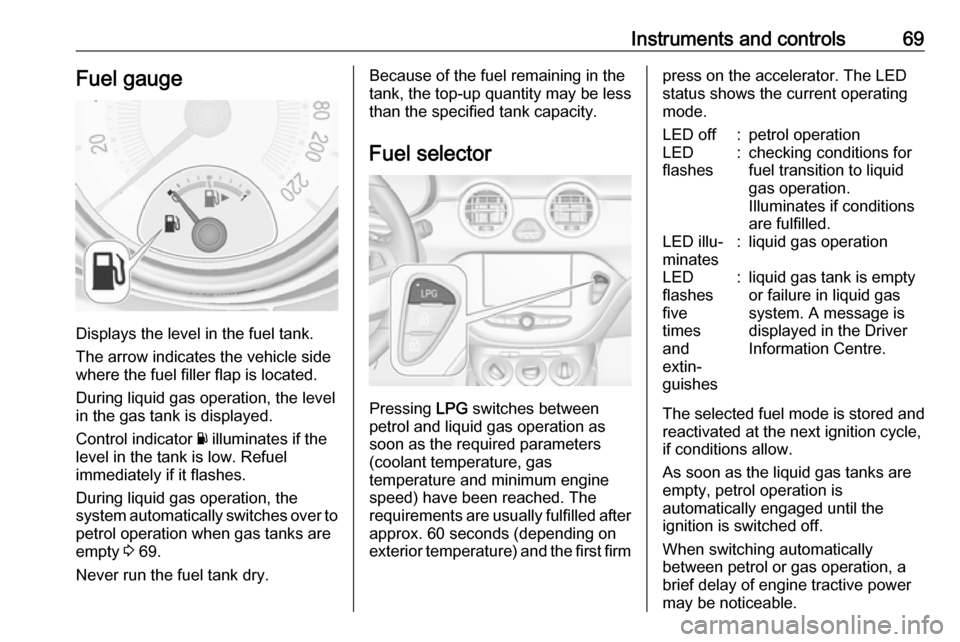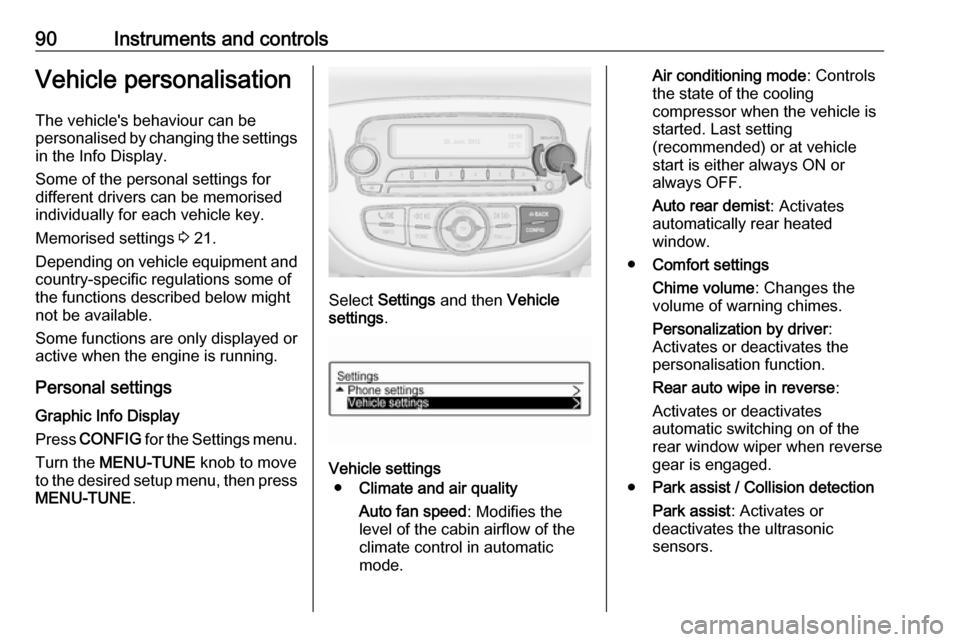ECO mode VAUXHALL ADAM 2019 Owner's Manual
[x] Cancel search | Manufacturer: VAUXHALL, Model Year: 2019, Model line: ADAM, Model: VAUXHALL ADAM 2019Pages: 223, PDF Size: 6.54 MB
Page 5 of 223

Introduction3Vehicle specific dataPlease enter your vehicle's data on
the previous page to keep it easily
accessible. This information is
available in the sections "Service and
maintenance" and "Technical data"
as well as on the identification plate.
Introduction
Your vehicle is a designed
combination of advanced technology, safety, environmental friendliness
and economy.
This Owner's Manual provides you
with all the necessary information to
enable you to drive your vehicle
safely and efficiently.
Make sure your passengers are
aware of the possible risk of accident
and injury which may result from
improper use of the vehicle.
You must always comply with the
specific laws and regulations of the
country that you are in. These laws
may differ from the information in this Owner's Manual.
Disregarding the description given in
this manual may affect your warranty.When this Owner's Manual refers to a
workshop visit, we recommend your
Vauxhall Authorised Repairer.
For gas vehicles, we recommend a
Vauxhall Authorised Repairer
licensed to service gas vehicles.
All Vauxhall Authorised Repairers
provide first-class service at
reasonable prices. Experienced
mechanics trained by Vauxhall work according to specific Vauxhall
instructions.
The customer literature pack should
always be kept ready to hand in the
vehicle.
Using this manual ● This manual describes all options
and features available for this
model. Certain descriptions,
including those for display and
menu functions, may not apply to
your vehicle due to model
variant, country specifications,
special equipment or
accessories.
● The "In brief" section will give you
an initial overview.● The table of contents at the beginning of this manual and
within each section shows where the information is located.
● The index will enable you to search for specific information.
● This Owner's Manual depicts left-
hand drive vehicles. Operation is similar for right-hand drive
vehicles.
● The Owner's Manual uses the engine identifier code. The
corresponding sales designation
and engineering code can be
found in the section "Technical
data".
● Directional data, e.g. left or right, or front or back, always relate to
the direction of travel.
● Displays may not support your specific language.
● Display messages and interior labelling are written in bold
letters.
Page 13 of 223

In brief111Power windows .....................27
2 Exterior mirrors .....................26
3 Cruise control .....................129
Speed limiter ....................... 130
4 Side air vents ...................... 113
5 Turn lights, headlight
flash, low beam and high
beam ................................... 101
Exit lighting ......................... 104
Parking lights ...................... 101
Buttons for Driver
Information Centre ................80
6 Instruments .......................... 68
7 Steering wheel controls .......61
8 Driver Information Centre ...... 80
9 Windscreen wiper,
windscreen washer
system, headlight washer
system, rear wiper, rear
washer system ......................62
10 Central locking system ..........21
City mode ............................ 128
Fuel selector ......................... 69Eco button for stop-start
system ................................. 118
Traction Control system .....125
Electronic Stability Control . 126
Parking assist ..................... 132
Seat heating .......................... 35
Heated steering wheel ..........61
11 Info Display .......................... 85
12 Hazard warning flashers ....100
Control indicator for airbag
deactivation .......................... 75
Control indicator for front
passenger seat belt .............74
13 Sensor electronic climate
control system ....................109
14 Centre air vents .................. 113
15 Side air vents passenger
side ..................................... 113
16 Glovebox .............................. 51
Fuse box ............................ 167
17 Climate control system ........ 106
18 Power outlet .......................... 66
19 AUX input, USB input ...........1020Selector lever,
transmission ....................... 123
21 Parking brake ......................124
22 Ignition switch with
steering wheel lock ............116
23 Horn ..................................... 62
Driver airbag ........................ 42
24 Bonnet release lever ..........150
25 Steering wheel adjustment ..61
26 Light switch .......................... 98
Headlight range
adjustment ......................... 100
Rear fog light ...................... 101 Brightness of instrument
panel illumination ................102
Brightness of ambient light 102
Page 71 of 223

Instruments and controls69Fuel gauge
Displays the level in the fuel tank.
The arrow indicates the vehicle side
where the fuel filler flap is located.
During liquid gas operation, the level
in the gas tank is displayed.
Control indicator Y illuminates if the
level in the tank is low. Refuel
immediately if it flashes.
During liquid gas operation, the
system automatically switches over to
petrol operation when gas tanks are
empty 3 69.
Never run the fuel tank dry.
Because of the fuel remaining in the
tank, the top-up quantity may be less
than the specified tank capacity.
Fuel selector
Pressing LPG
switches between
petrol and liquid gas operation as
soon as the required parameters (coolant temperature, gas
temperature and minimum engine
speed) have been reached. The
requirements are usually fulfilled after
approx. 60 seconds (depending on
exterior temperature) and the first firm
press on the accelerator. The LED
status shows the current operating
mode.LED off:petrol operationLED
flashes:checking conditions for
fuel transition to liquid
gas operation.
Illuminates if conditions
are fulfilled.LED illu‐
minates:liquid gas operationLED
flashes
five
times
and
extin‐
guishes:liquid gas tank is empty
or failure in liquid gas
system. A message is
displayed in the Driver
Information Centre.
The selected fuel mode is stored and reactivated at the next ignition cycle,
if conditions allow.
As soon as the liquid gas tanks are
empty, petrol operation is
automatically engaged until the
ignition is switched off.
When switching automatically
between petrol or gas operation, a
brief delay of engine tractive power
may be noticeable.
Page 85 of 223

Instruments and controls83On vehicles with LPG engines:
Average consumption is indicated for
the currently selected mode (LPG or
petrol).
Average speed
Display of average speed. The
measurement can be reset at any
time.
To reset, press SET/CLR for a few
seconds on the respective page.
Digital speed
Digital display of the instantaneous
speed.
Fuel range
Range is calculated from current fuel
tank level and current consumption.
The display shows average values.
After refuelling, the range is updated
automatically after a brief delay.
When the fuel level in the tank is low,
a message appears on the display.
Y in the fuel gauge illuminates.
When the tank must be refuelled
immediately, a warning message
pops-up on the display. Y in the fuel
gauge flashes.Low fuel Y 3 79.
Fuel range LPG version
Display of approximate fuel range
available with the remaining fuel in
each respective fuel tank of petrol and
LPG fuel, along with a total range of
both fuel types together. Switch
between the mode by pressing
SET/CLR .
Instantaneous consumption
Display of the instantaneous
consumption.
On vehicles with LPG engines:
Instantaneous consumption is
indicated for the currently selected
mode; LPG or petrol.
Vehicle Information Menu X
Press MENU to select the Vehicle
Information page.
Turn the adjuster wheel to select a
submenu.
Follow the instructions given in the
submenus.● Unit
Press SET/CLR while page is
displayed. Select imperial
(unit 1) or metric (unit 3) by
turning the adjuster wheel. Press
SET/CLR to set the unit.
● Tyre Pressure
Tyre pressure of all wheels is
displayed on this page during
driving 3 172.
● Tyre Load
The tyre pressure category
according to the actually inflated
tyre pressure can be selected
3 172.
Page 92 of 223

90Instruments and controlsVehicle personalisationThe vehicle's behaviour can be
personalised by changing the settings in the Info Display.
Some of the personal settings for
different drivers can be memorised
individually for each vehicle key.
Memorised settings 3 21.
Depending on vehicle equipment and
country-specific regulations some of
the functions described below might
not be available.
Some functions are only displayed or
active when the engine is running.
Personal settings Graphic Info Display
Press CONFIG for the Settings menu.
Turn the MENU-TUNE knob to move
to the desired setup menu, then press MENU-TUNE .
Select Settings and then Vehicle
settings .
Vehicle settings
● Climate and air quality
Auto fan speed : Modifies the
level of the cabin airflow of the
climate control in automatic
mode.
Air conditioning mode : Controls
the state of the cooling
compressor when the vehicle is
started. Last setting
(recommended) or at vehicle
start is either always ON or
always OFF.
Auto rear demist : Activates
automatically rear heated
window.
● Comfort settings
Chime volume : Changes the
volume of warning chimes.
Personalization by driver :
Activates or deactivates the
personalisation function.
Rear auto wipe in reverse :
Activates or deactivates
automatic switching on of the
rear window wiper when reverse gear is engaged.
● Park assist / Collision detection
Park assist : Activates or
deactivates the ultrasonic
sensors.
Page 112 of 223

110Climate controlV:demisting and defrostingÜ:heated rear window 3 29
Heated seats ß 3 35.
Heated steering wheel * 3 61.
In automatic mode temperature, fan speed and air distribution are
regulated automatically.
Climate control settings are shown on the Info Display. Setting modifications
are briefly popped-up, superimposed
over the currently displayed menu.
The electronic climate control system is only fully operational when the
engine is running.
Automatic mode AUTO
Basic setting for maximum comfort:
● Press AUTO, the air distribution
and fan speed are regulated
automatically. The LED in the
button illuminates to indicate
activation.
● Open all air vents to allow optimised air distribution in
automatic mode.
● Press n to switch on optimal
cooling and demisting. The LED in the button illuminates to
indicate activation.
● Set the preselected temperature using the centre rotary knob.Recommended temperature is
22 °C.
Temperature preselection
Set temperature by turning the centre
rotary knob to the desired value. It is
indicated in the display of the switch.
For reasons of comfort, change
temperature only in small increments.
Page 136 of 223

134Driving and operatingFront-rear parking assist is always
combined with advanced parking
assist, see "Advanced parking assist"
section below.
Parking assist button D and
operation logic
Front-rear parking assist and
advanced parking assist both use the same button for activation and
deactivation:
A brief press of D activates or
deactivates the parking assist.
A long press of D (approx.
1 second) activates or deactivates the
advanced parking assist, see
separate description.
Button logic operates the systems by
pressing D as follows:
● If only front-rear parking assist is active, a brief press deactivates
front-rear parking assist.
● If only front-rear parking assist is active, a long press activates
advanced parking assist.
● If only advanced parking assist is
active and the system is in
parking slot searching mode, a
brief press activates front-rear
parking assist.
● If only advanced parking assist is
active and the system is in park
guiding mode, a brief press
deactivates advanced parking
assist.
● If advanced parking assist is active, a long press deactivates
advanced parking assist and front-rear parking assist.● If a forward gear or neutral is selected, a brief press activates
or deactivates only front parking
assist.
● If reverse gear is selected, a brief
press activates or deactivates
front and rear parking assist.
Activation
The system is activated automatically
at a speed up to 7 mph.
An illuminated LED in the parking
assist button D indicates that the
system is ready to operate.
If D is switched off within an ignition
cycle, the front parking assist is
deactivated. If vehicle speed has
exceeded 15 mph beforehand, parking assist will be reactivatedwhen speed drops below 7 mph.
When the system is deactivated, the
LED in the button extinguishes and a
message pops-up in the Driver
Information Centre.
Page 139 of 223

Driving and operating137Button logic operates the systems by
pressing D as follows:
● If only front-rear parking assist is active, a brief press deactivates
front-rear parking assist.
● If only front-rear parking assist is active, a long press activates
advanced parking assist.
● If only advanced parking assist is
active and the system is in
parking slot searching mode, a
brief press activates front-rear
parking assist.
● If only advanced parking assist is
active and the system is in park
guiding mode, a brief press
deactivates advanced parking
assist.
● If advanced parking assist is active, a long press deactivates
advanced parking assist and front-rear parking assist.● If forward gear or neutral is selected, a brief press activates
or deactivates front parking
assist.
● If reverse gear is selected, a brief
press activates or deactivates
front and rear parking assist.
Activation
When searching for a parking slot, the
system is ready to operate with a long press of D.
The system recognises and
memorises 10 m for parallel parking
slots or 6 m for perpendicular parking
slots in the parking assist mode.
The system can only be activated at
a speed up to 18 mph and the system searches for a parking slot at a speed
up to 18 mph.
The maximum allowed parallel
distance between the vehicle and a
row of parked cars is 1.8 m for parallel
parking and 2.5 m for perpendicular
parking.
FunctionalityParking slot searching mode
Indication in the Driver Information
Centre
Page 177 of 223

Vehicle care175The tyre pressure sensor matching
process is:
1. Apply the parking brake.
2. Turn the ignition on.
3. On vehicles with manual transmission: select neutral.
4. Use MENU on the stalk to select
the Vehicle Information Menu in
the Driver Information Centre.
5. Turn the adjuster wheel to scroll to
the tyre pressure menu.
6. Press SET/CLR to begin the
sensor matching process. A
message requesting acceptance
of the process should be
displayed.
7. Press SET/CLR again to confirm
the selection. The horn sounds
twice to indicate that the receiver
is in relearn mode.
8. Start with the left side front wheel.
9. Place the relearn tool against the tyre sidewall, near the valve stem.Then press the button to activate
the tyre pressure sensor. A hornchirp confirms that the sensor
identification code has been
matched to this wheel position.
10. Proceed to the right side front wheel, and repeat the procedure
in Step 9.
11. Proceed to the right side rear wheel, and repeat the procedure
in Step 9.
12. Proceed to the left side rear wheel, and repeat the procedure
in Step 9. The horn sounds twice
to indicate that the sensor
identification code has been
matched to the left side rear
wheel, and the tyre pressure
sensor matching process is no
longer active.
13. Turn off the ignition.
14. Set all four tyres to the recommended air pressure level
as indicated on the tyre
information label.
15. Ensure the tyre loading status is set according to the selected
pressure 3 80.Tread depth
Check tread depth at regular
intervals.
Tyres should be replaced for safety
reasons at a tread depth of 2-3 mm
(4 mm for winter tyres).
For safety reasons it is recommended
that the tread depth of the tyres on
one axle should not vary by more than 2 mm.
The legally permissible minimum
tread depth (1.6 mm) has been
reached when the tread has worn
down as far as one of the tread wear